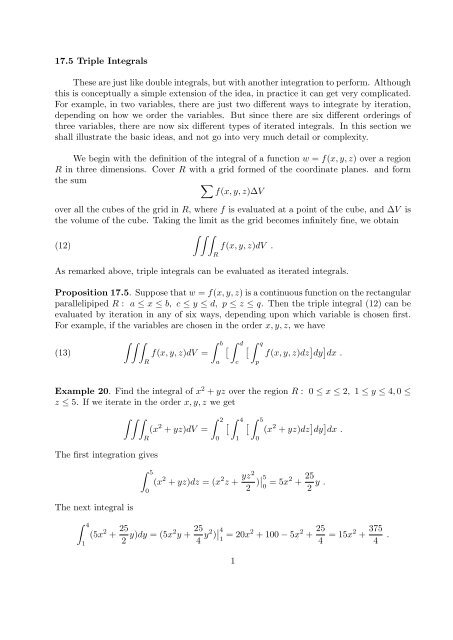17.5 Triple Integrals These are just like double integrals, but with ...
17.5 Triple Integrals These are just like double integrals, but with ...
17.5 Triple Integrals These are just like double integrals, but with ...
Create successful ePaper yourself
Turn your PDF publications into a flip-book with our unique Google optimized e-Paper software.
volume of the figure in R corresponding to a typical cube in the grid on S. This will bean approximation to (15), which gets better as the grid gets finer.If the grid is sufficiently fine, we can, at each cube, approximate by the linear approximationto the change of variables:dX = X u du + X v dv + X w dw .A cube in S of side lengths du, dv, dw corresponds to the parallelipiped in R spannedby the vectors X u du, X v dv, X w dw, and the volume of that parallelipiped is(17) dV = | det(X u , X v , X w )|dudvdw .The factor in (17) is called the Jacobian of the variable change, and is calculated as the(absolute value of the) determinant of the matrix whose rows <strong>are</strong> X u , X v , X w . Thismatrix is denoted by⎛ ∂x ∂y ∂z ⎞∂u ∂u ∂u∂(x, y, z)∂(u, v, w) = ⎝ ∂x ∂y ∂z ⎠∂v ∂v ∂v.∂x∂wProposition 17.7. Suppose that we <strong>are</strong> given the change of variables (16) so that theregion R in (x, y, z) space corresponds to the region S in (u, v, w) space. Then we cancalculate triple <strong>integrals</strong> by integrating over S as follows:∫ ∫ ∫R∫ ∫ ∫f(X)dxdydz =S∂y∂w∂z∂wf(X(u, v, w)) ∣ ∂(x, y, z) ∣∣dudvdw .∂(u, v, w)Example 24. Find the volume of the region R given by the inequalities0 ≤ z ≤ 4 , 0 ≤ y + z ≤ 3 , 0 ≤ x + y + z ≤ 5 .This region is a parallelipiped, so by the appropriate change of coordinates, can be madeto correspond to a rectangular parallelipiped. That is, we make the change of variablesu = x + y + z , v = y + z , w = zso that R corresponds to the region S given by the inequalities 0 ≤ u ≤ 5, 0 ≤ v ≤ 3, 0 ≤w ≤ 4. Thus∫ ∫ ∫V olume =R∫ ∫ ∫dxdydz =S∣∂(x, y, z) ∣∣dudvdw .∂(u, v, w)Now, to calculate the Jacobian, we solve for x, y, z in terms of u, v, w:x = u − v , y = v − w , z = w ,5
so thatThus⎛∂(x, y, z)∂(u, v, w) = det ⎝ 1 0 0⎞−1 1 0 ⎠ = 1 .0 0 1V olume =∫ 5 ∫ 3 ∫ 4000dudvdw = 60 .When we make a linear change of variables the Jacobian is a constant (<strong>but</strong> not always 1,as above). By using the following fact about determinants, we need not actually solve forx, y, z in terms of u, v, w:(18)∂(x, y, z) ∂(u, v, w)∂(u, v, w) ∂(x, y, z) = 1 .Example 25. Let u = 3x − y + z, v = x + y + 2z, w = x − z. Find the volume of theparallelipiped given by the inequalities −2 ≤ u ≤ 3, 0 ≤ v ≤ 4, 2 ≤ u ≤ 7.We calculateThus, by (18),so that⎛∂(u, v, w)∂(x, y, z) = det ⎝ 3 1 1⎞−1 1 0 ⎠ = −7 .1 2 −1V olume =∂(x, y, z)∂(u, v, w) = −1 7 ,∫ 3−2∫ 4 ∫ 7021 100dudvdw =7 7 .Usually, we change coordinates only when the statement of the problem stronglysuggests a different set of coordinates. Thus, if the problem has symmetry about the z-axis, we may change to spherical coordinates, and if there is symmetry about the origin, anchange to spherical coordinates is indicated. The calculation of theJacobians for cylindricaland spherical coordinates leads to these expressions:Cylindrical coordinates: dV = rdrdθdz.Spherical coordinates: dV = ρ 2 sin φdρdθdφ.Example 26. Find the volume and the centroid of the region bounded by the hyperboloidx 2 + y 2 − z 2 = 1 and the planes z = 0, z = 2.Here, because of the symmetry about the z-axis, we <strong>are</strong> led to cylindrical coordinates. Inthese coordinates, the region is given by 0 ≤ θ ≤ 2π, 0 ≤ z ≤ 2, 0 ≤ r ≤ √ 1 + z 2 . Thus∫ ∫ ∫∫ ∫ ∫∫ 2π ∫ 2 ∫ √ 1+z 2V olume = dxdydz = rdrdzdθ = [ [ rdr]dz]dθ .RR6000
















